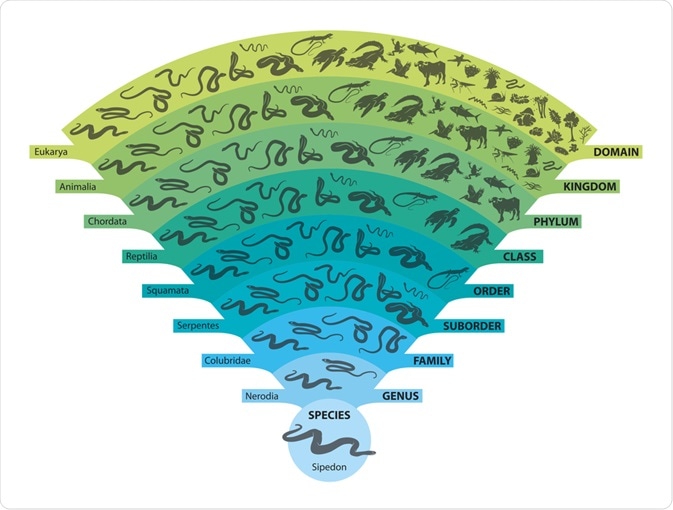The word taxonomy is derived from the Greek tasso, meaning ‘arrange’. The science of naming and classifying organisms into systematic hierarchies comprising groups ––or taxa ––is based on an analysis of shared characteristics and natural relationships.

Image Credit: EreborMountain/Shutterstock.com
There are eight levels of classification in modern taxonomy, with domain at the top, and species at the bottom (more on this below), although plant taxonomy has only a clade between family and kingdom (Plantae).
As the key terms are interrelated, they can easily become confusing to the uninitiated. This article, therefore, aims at defining these key categories of biology and the life sciences. The definitions given can of course be defined further according to subject specialisms within biology.
What is classification?
Classification is the process of grouping organisms together either based on features they have in common, or based on their ancestry, or sometimes both. This results in the arrangement of living things into groups.
This organization of organisms into categories is carried out based on their appearance, structure, genetic sequence, or evolution. It is a natural system of classification. The resulting hierarchical categories from the most inclusive, whereby organisms have fewer features in common, to the narrowest and therefore most exclusive, (with more features in common) are given as follows:
- Domain
- Kingdom
- Phylum
- Class
- Order
- Family
- Genus
- Species,
- Variety
For example, see the following table for the classification of the domestic dog:
| Domestic dog ––Canis lupus familiaris |
| Kingdom |
Animalia |
| Phylum* |
Chordata |
| Class |
Mammalia |
| Order |
Carnivora |
| Family |
Canidae |
| Genus |
Canis |
| Species |
Canis familiaris |
*In plant classification the phylum was replaced with ‘division’ alternatively ‘clade’ is used (see above) as the only category between Kingdom and Family.
The traditional division of living organisms into two kingdoms (Plant and Animal) dates to Carl Linnaeus (1707-1778), the Swedish Botanist, Zoologist, Taxonomist and Physician who is best known for his systematic classification of living organisms, such that he is now referred to as the Father of Taxonomy.
The Linnaean system of classification was later succeeded by a system of five kingdoms (Bacteria, Protists, Fungi, Plants, and Animals) proposed by Robert Whittaker (1920-1980) in 1969. In turn, this system was replaced by a seven-kingdom system proposed by T. Cavalier-Smith. This system retained four of the five kingdoms but split protists into three separate kingdoms: Archaeprotista, Protozoa, and Chromista.
Up until the mid-twentieth century classification was largely descriptive and based on making comparisons of forms and structures from within specialist subject areas. In the 1960s automated sequencing of genetic data became possible. Contemporary natural classifications use quantitative methods and are predictive. They try to consider as many features as possible and aim to reflect the phylogeny of organisms, i.e., the history of their evolutionary relationships –thus if an organism is placed in a particular genus, then it is very likely to possess most (if not all) of the other features of that genus. Nowadays these include both macro-and micromorphological characters.
Different disciplinary areas may vary in the methodologies used. In ecological and taxonomic studies, for example, sophisticated numerical classification schemes have been devised, and the methods developed in these disciplines are being applied increasingly in other fields such as paleontology.
What is taxonomy?
Taxonomy is the scientific classification of organisms. More definitively it is the classification of living and extinct organisms —i.e., biological classification. Taxonomy involves studying the theory, practice, and rules of classification of living and extinct organisms. The naming, description, and classification of a given organism draws on evidence from several fields:
- Classical taxonomy
- based on morphology and anatomy
- Cytotaxonomy
- compares the size, shape, and number of chromosomes of different organisms
- Numerical taxonomy
- uses mathematical procedures to assess similarities and differences and establish taxonomic groups
- Modern taxonomy
- classifies organisms according to their evolutionary history (i.e., phylogeny)
Introduction to Taxonomy
What is nomenclature?
The naming of species according to rules developed by international associations of taxonomists. There are several published codes all of which continue to be revised:
- the International Code of Zoological Nomenclature (ICZN)
- the International Code for the Nomenclature of Algae, Fungi, and Plants
(Formerly the International Code of Botanical Nomenclature (ICBN))
- the International Code of Nomenclature for Cultivated Plants (ICNCP)
- the International Code for the Nomenclature of Bacteria (ICNB)
- the International Code of Virus and Nomenclature (ICVCN)
The underlying principle for each taxon involves the allocation of a single ambiguous name.
Within the confines of botany, Carl Linnaeus remains the authority on the naming of plants, and his 1753 publication Species Plantarum, is usually taken as a starting point. Meanwhile, the naming of Fungi, fossil plants, and Bacteria starts from different dates and involves different authorities.
Sources:
- https://www.britannica.com/science/taxonomy
- Allaby, M. (2015) A Dictionary of Ecology. Oxford University Press.
- Hine, R. (2019) A Dictionary of Biology. Oxford University Press.
- King, R. et al. (2013) A Dictionary of Genetics. Oxford University Press.
- Marzouk, R. et al. (2021) Comparative Taxonomic Study of Launaea Cass. (Asteraceae, Cichorioideae) in Egypt. Taxonomy.
- doi: https://doi.org/10.3390/taxonomy1030014
- Park, C. and Allaby, M. (2017) A Dictionary of Environment and Conservation. Oxford University Press.
Further Reading
Last Updated: Oct 27, 2021